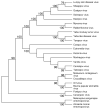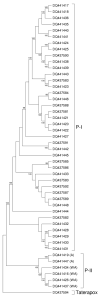The evolutionary biology of poxviruses
- PMID: 19833230
- PMCID: PMC2818276
- DOI: 10.1016/j.meegid.2009.10.001
The evolutionary biology of poxviruses
Abstract
The poxviruses (family Poxviridae) are a family of double-stranded viruses including several species that infect humans and their domestic animals, most notably Variola virus (VARV), the causative agent of smallpox. The evolutionary biology of these viruses poses numerous questions, for which we have only partial answers at present. Here we review evidence regarding the origin of poxviruses, the frequency of host transfer in poxvirus history, horizontal transfer of host genes to poxviruses, and the population processes accounting for patterns of nucleotide sequence polymorphism.
Copyright 2009 Elsevier B.V. All rights reserved.
Figures






References
-
- Anderson FE, Swofford DL. Should we be worried about long-branch attraction in real data sets? : Investigations using metazoan 18S rRNA. Mol Phyl Evol. 2004;33:440–451. - PubMed
-
- Babkin IV, Shchelkunov SN. [The time scale in poxvirus evolution] Mol Biol (Mosk) 2006;40:20–24. [in Russian]. - PubMed
-
- Bartlett NW, Dumoutier L, Renauld JC, Kotenko SV, McVey CE, Lee HJ, Smith GL. A new member of the interleukin 10-related cytokine family encoded by a poxvirus. J Gen Virol. 2004;85:1401–1412. - PubMed
-
- Baxby D. Jenner’s Smallpox Vaccine: the Riddle of the Origin of Vaccinia Virus. Heinemann; London: 1981.
Publication types
MeSH terms
Grants and funding
LinkOut - more resources
Full Text Sources

